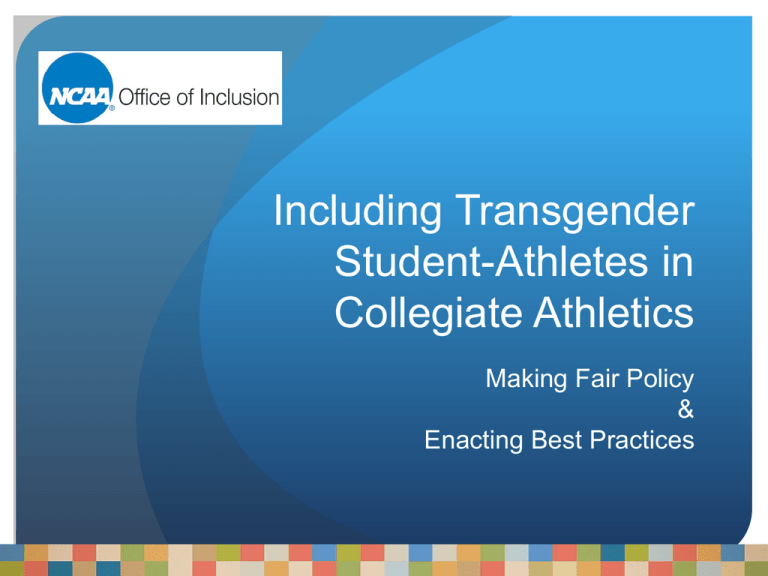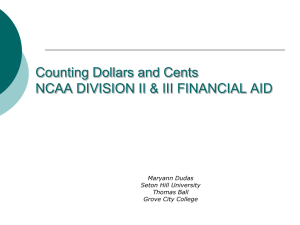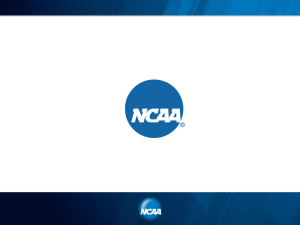
Including Transgender
Student-Athletes in
Collegiate Athletics
Making Fair Policy
&
Enacting Best Practices
Transgender Student-Athlete
Participation
Participation in athletics provides studentathletes a unique and positively powerful
experience. As a higher educational
association, the NCAA and its member
institutions govern athletics programs in
accordance with the Association’s core
mission to assure safe and equitable
opportunities for participation.
Workshop Objectives
To provide a basic understand of transgender identity
To understand why collegiate athletic programs need to
address the participation of transgender student-athletes
To discuss questions related to the inclusion of
transgender student-athletes
To identify recommended policies and best practices for
including transgender student-athletes on school teams
Who Are Transgender StudentAthletes?
Transgender students’ internal sense of
their gender does not match the sex/gender
they were assigned at birth
Why Address Transgender Athlete
Issues?
Estimates are that 1-2% of the population identifies
as transgender
More young people are identifying as transgender at
younger ages
In recent years, the NCAA has had at least 40
inquiries from member schools about how to include
transgender students on athletic teams
Why Address Transgender Athlete
Issues?
Participation in athletics contributes to students’
overall educational experience
The NCAA is a part of the higher education
community and supports a broad commitment to
inclusion and equal access
Why Include Transgender StudentAthletes on Collegiate Sports Teams?
Commitment to Diversity & Inclusion
Commitment to Equal Opportunity
School Non-Discrimination Policy
State and Federal Laws
First, A Few Definitions to Make
Sure We Have A Common
Vocabulary
Towards A Common Vocabulary
Transgender - A person whose gender identity does not
match the sex/gender assigned at birth.
A transgender woman (MTF) was born with a male body but
identifies as a girl/woman
A transgender man (FTM) was born with a female body but
identifies as a boy/man
Toward A Common Vocabulary
Biological Sex
Sex/Gender Assigned at Birth
Gender Identity
Gender Expression
Sexual Orientation
Transgender
Intersex (Differences in Sexual Development)
Toward A Common Vocabulary
Biological Sex – The anatomical, physiological,
hormonal, genetic characteristics that we are
born with
Sex/Gender Assigned at Birth – Assignment of
boy or girl based on appearance of external
genitals
Toward A Common Vocabulary
Gender Identity – A person’s internal sense of
being a woman/girl, man/boy
Gender Expression – The behavior and
appearance characteristics used to express our
gender identity. Many characteristics are based
on social expectations of what is appropriate for
girls/women or for boys/men.
Toward A Common Vocabulary
Sexual Orientation – A person’s sexual desires,
behaviors, fantasies directed toward someone of
another sex (heterosexual), the same sex (lesbian,
gay), or any sex (bisexual).
Transgender - A person whose gender identity does
not match the sex/gender assigned at birth.
Toward A Common Vocabulary
Intersex – A person born with both male and female
anatomical, physiological, genetic characteristics (Also
called differences of sexual development).
One in 2,000 babies are born intersex
What We Assume About Sex, Gender
and Sexuality
Biological
Sex
Gender
Assigned
at Birth
Gender
Identity
Gender
Expression
Linear Relationship Among
Sex, Gender and Sexuality
Sexual
Orientation
Binary & Fixed Assumptions
Female
Bodied
Girl/Woman
Feminine
Heterosexu
al
Intersex
Male
Bodied
Boy/Man
Masculine
Heterosexu
al
Lived Experiences of Sex, Gender &
Sexuality
Biological Sex
Gender/Sex
Assigned at
Birth
Gender
Expression
Gender Identity
Sexual
Orientation
What Does Transitioning Genders
Mean?
Social Transitioning – choosing a name,
behavior and appearance characteristics
that express one’s gender identity.
o Name, pronouns
o Hair style
o Clothes
o Voice
What Does Transitioning Genders
Mean?
Medical Transitioning – Taking hormones and/or
having surgery to better match one’s body to one’s
gender identity.
Many transgender people choose not to have
surgery.
Trends in Federal Policies Prohibiting
Discrimination Based on Gender
Identity/Expression
Title IX - Addresses Discrimination Based on
Gender Stereotypes
Student Non-Discrimination Act (Introduced in U.S.
Congress in 2010)
Employment Non-Discrimination Act (ENDA)
(Introduced in the U.S. Congress in 2010)
State Laws Prohibiting Discrimination
Based on Gender Identity/Expression
California
Colorado
Illinois
Iowa
New Hampshire,
Minnesota
Maine
Washington
New Jersey
Oregon
Vermont
District of Columbia
School Policies Prohibiting
Discrimination Based on Gender
Identity/Expression
377 Colleges and Universities in the United States
Have Non-Discrimination Policies that Include
Gender Identity/Expression
Transgender Law and Policy Center
http://www.transgenderlaw.org/college/index.htm#policies
NCAA Considerations
What About Competitive Equity?
Do Transgender Women Have An Unfair
Competitive Advantage When Competing With
Women identified as Female at Birth?
Addressing Concerns about Unfair
Competitive Advantage
We already accept many competitive advantages
among women and among men as part of the game
o
o
o
o
o
Physical differences (Weight, height, strength, etc)
Genetic conditions ( Marfans Syndrome, etc)
Access to excellent coaching, training, equipment
Access to good nutrition, clean air and water
Access to social support and reward for athletic abilities
Addressing Concerns About Competitive
Equity: M2F Transgender Athletes on
Women’s Teams
Wide range of physiological difference and athletic
abilities among women athletes
Overlap of physiological differences and athletic abilities
between women and men
Student-Athletes Who Take Hormones As
Part of a Gender Transition After Puberty
Available medical research indicates that:
After one year of taking estrogen, the hormone
levels of transgender women fall within the range
for non-transgender women
Transgender men taking testosterone experience
increases in strength almost immediately that
could provide a competitive advantage in
competition on women's teams
Student-Athletes Who Take Hormones
as Part of a Gender Transition After
Puberty
Transgender women and men who take hormones have
strength and endurance levels that are within the typical
range for non-transgender athletes of their gender after
one year of hormone treatment.*
* van Kesteren P, Lips P, Deville W, Popp-Snijders C, Asscheman H, Megens J &
Gooren L. The effect of one-year cross-sex hormonal treatment on bone
metabolism and serum insulin-like growth factor-1 in transsexuals. Journal of
Clinical Endocrinology and Metabolism 1996 81 2227–2232.
Student-Athletes Who Transition
Gender After Puberty
Transgender women do retain the effects of bone
growth triggered by testosterone production during
male puberty
Transgender men taking testosterone will not have
the bone growth that occurs during a male puberty
Not all transgender women are big boned or tall
Not all transgender men are slight and short
Policy Recommendation
Slides 30-36 on hold
A transgender student-athlete at the college level should
be allowed to participate in any sex-separated sports
activity so long as that athlete’s use of hormone therapy,
if any, is consistent with the National Collegiate Athletic
Association’s (NCAA) existing policies on banned
medications.
Transgender Student-Athlete
Participation & Hormone Treatment for
the Purpose of Gender Transition
A [trans male] student-athlete who has received a medical
exception for treatment with testosterone for gender transition,
for purposes of NCAA competition, may compete on a men’s
team, but is no longer eligible to compete on a women’s team
without changing that team status to a mixed team.
A [trans female] student-athlete being treated with
testosterone suppression medication for gender transition, for
the purposes of NCAA competition, may continue to compete
on a men’s team but may not compete on a women’s team
without changing it to a mixed team status until completing
one calendar year of testosterone suppression treatment.
Policy Recommendations For StudentAthletes Undergoing Hormone Treatments
It is the responsibility of the NCAA institution to submit
the request for a medical exception for testosterone
treatment prior to the student-athlete competing while
undergoing treatment. In the case of testosterone
suppression, the institution must submit written
documentation of the year of treatment and ongoing
monitoring of testosterone suppression.
For the purpose of NCAA competition, interruptions of
treatments for gender transition will be reviewed on a
case by case basis.
Policy Recommendations For StudentAthletes Undergoing Hormone Treatments
A male-to-female (MTF) transgender student-athlete who is taking
medically prescribed hormone treatment related to gender transition
may participate on a men’s team at any time, but must complete one
year of hormone treatment related to gender transition before
competing on a women’s team.
A female-to-male (FTM) transgender student-athlete who is taking
medically prescribed testosterone related to gender transition may
not participate on a women’s team after beginning hormone
treatment, and must request a medical exception from the NCAA
prior to competing on a men’s team because testosterone is a
banned substance.
A female-to-male (FTM) transgender student-athlete who is taking
medically prescribed testosterone for the purposes of gender
transition may compete on a men’s team.
In any case where a student-athlete is taking hormone treatment
related to gender transition, that treatment must be monitored by a
physician, and the NCAA must receive regular reports about the
athlete’s eligibility according to these guidelines.
Policy Recommendations for Transgender
Student-Athletes Who are NOT Undergoing
Hormone Treatment
Any transgender student-athlete who is not taking hormone
treatment related to gender transition may participate in sexseparated sports activities in accordance with his or her
assigned birth gender.
A female-to-male transgender student-athlete who is not
taking testosterone related to gender transition may participate
on a men’s or women’s team.
A male-to-female transgender student-athlete who is not
taking hormone treatments related to gender transition may
not compete on a women’s team.
Participation on Mixed Teams
Transgender Student-Athletes Taking
Hormones
For purposes of mixed gender team classification, a male-tofemale (MTF) transgender student-athlete who is taking
medically prescribed hormone treatment related to gender
transition shall be counted as a male participant until the
athlete has completed one year of hormone treatment at which
time the athlete shall be counted as a female participant.
For purposes of mixed gender team classification, a female-tomale (FTM) transgender student-athlete who is taking
medically prescribed testosterone related to gender transition
shall be counted as a male participant and must request a
medical exception from the NCAA prior to competing because
testosterone is a banned substance.
Participation on Mixed Teams
Transgender Student-Athletes Not
Taking Hormones
For purposes of mixed gender team classification, a female-tomale (FTM) transgender student-athlete who is not taking
testosterone related to gender transition may be counted as
either a male or female.
For purposes of mixed gender team classification, a female-tomale (FTM) transgender student-athlete who is not taking
testosterone related to gender transition participating on a
women’s team shall not make that team a mixed gender team.
For purposes of mixed gender team classification, a male-tofemale (MTF) transgender student-athlete who is not taking
hormone treatment related to gender transition shall count as a
male.
Best Practice Recommendations:
Education
All members of the school community
should receive information about
transgender identities, non-discrimination
policies, the use of pronouns and chosen
names, and expectations for creating a
respectful school and team climate for all
students, including transgender students.
Best Practice Recommendations:
Facilities Access
Transgender student-athletes should be able to use
locker rooms and bathrooms in accordance with their
identified gender
Every locker room and toilet area should have provisions
for privacy accessible to all students
When requested by a transgender student-athlete,
separate changing and toilet facilities should be provided
Best Practice Recommendations:
Facilities Access
Many schools have already accommodated facilities
use by transgender students and staff.
Athletics staff should work with colleagues on
campus for implementing best practices for facilities
use.
Best Practice Recommendations:
Hotel Rooms
Transgender student-athletes should be assigned
hotel rooms according to their identified gender in
the same manner that other members of the team
are assigned rooms
Provisions should be made for any student-athlete
who need extra privacy whenever possible
Best Practice Recommendations:
Language
Coaches, teammates and media should refer to
transgender athletes by their preferred name
When referring to a transgender student-athlete,
coaches, teammates and media should use
pronouns that reflect the student-athlete’s identified
gender
Best Practice Recommendations:
Dress Codes
Transgender student-athletes should be able to
dress in accordance with their identified gender
Dress codes for athletic teams should be genderneutral (For example: Do not require women to wear
dresses or skirts. Instead require attire that is neat,
clean and appropriate for the occasion)
Best Practice Recommendations:
Team Uniforms
All team members should have access to uniforms
that are appropriate for their sport and that they feel
comfortable wearing.
No student should be required to wear a gendered
uniform that conflicts with the student’s gender
identity.
Best Practices: Media
Provide Training to All Staff Who Interact
with the Media
Respect confidentiality. All medical information must be
kept confidential in accordance with applicable state,
local, and federal privacy laws.
Use appropriate language (transgender, preferred
pronouns and name) in media interviews and insist that
this terminology be used in media reports on transgender
issues in athletics.
Focus on the importance of providing equal
opportunities for all students to participate in athletics.
Describe how departmental policies provide equal
opportunities for all students.
Best Practices:
Communications with Opponents
Talk with athletic directors and coaches from other
schools prior to competitions about expectations for
treatment of transgender student-athletes on and off
the field.
Do not identify a particular student-athlete as
transgender, but rather establishing general
expectations for the treatment of all studentathletes, including those who may be transgender.
Overall Guidelines
Be Proactive, don’t wait for a crisis
Focus on inclusion, not exclusion
Protect the privacy of transgender student-athletes
Educate athletic staff and student-athletes about
gender transitions and athletics
NCAA Executive Committee
Framework for NCAA Inclusion
As a core value, the NCAA believes in and is committed to
diversity, inclusion and gender equity among its studentathletes, coaches and administrators. We seek to
establish and maintain an inclusive culture that fosters
equitable participation for student-athletes and career
opportunities for coaches and administrators from
diverse backgrounds. Diversity and inclusion improve
the learning environment for all student-athletes and
enhance excellence within the Association.
The Office of Inclusion will provide or enable programming and
education, which sustains foundations of a diverse and inclusive
culture across dimensions of diversity including, but not limited
to age, race, sex, class, creed educational background,
disability, gender expression, geographical location,
income, marital status, parental status, sexual orientation
and work experiences.
Primary Contacts
Bernard Franklin – bfranklin@ncaa.org (Executive VP, Chief Inclusion Officer)
Kimberly Ford - kford@ncaa.org (Minority Inclusion)
Karen Morrison - kmorrison@ncaa.org (Gender Inclusion and LGBT)
www.ncaa.org/gender_equity












